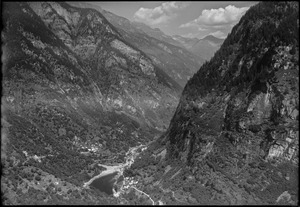Buseno facts for kids
Quick facts for kids
Buseno
|
||
|---|---|---|
|
||
| Country | Switzerland | |
| Canton | Graubünden | |
| District | Moesa | |
| Area | ||
| • Total | 11.15 km2 (4.31 sq mi) | |
| Elevation | 801 m (2,628 ft) | |
| Population
(Dec 2020 )
|
||
| • Total | 91 | |
| • Density | 8.16/km2 (21.14/sq mi) | |
| Postal code |
6542
|
|
| Surrounded by | Arvigo, Braggio, Castaneda, Roveredo, Santa Maria in Calanca, San Vittore | |
Buseno is a small town, also called a municipality, in the Moesa Region of Switzerland. It is located in the Swiss area known as Graubünden.
Buseno's History
Buseno became its own independent town in 1851. Before that, it was part of another town called Calanca.
The main church in Buseno is called SS. Pietro e Antonio. It was officially opened in 1483. Later, it was made bigger in 1776 and fixed up in 1990. A newer church, Nostra Signora di Fatima, was built in Giova between 1984 and 1988.
Where is Buseno?
Buseno covers an area of about 11.2 square kilometers (about 4.3 square miles). A small part of this land, about 5.6%, is used for farming. Most of the area, 82.2%, is covered by forests. About 1.9% of the land has buildings or roads, and the rest (10.3%) is made up of rivers, glaciers, or mountains.
The town of Buseno sits on a flat area next to the Calancasca river. Below Buseno, you'll find the village of Molina. Higher up are the mountain settlements of San Carlo and Giova. Giova used to belong to the town of San Vittore but became part of Buseno in 1899. Buseno was known as Busen until 1943.
People of Buseno
Buseno has a small population of about 92 people (as of December 2015). In 2008, about 7.3% of the people living there were from other countries. Over the past 10 years, the number of people living in Buseno has gone down by about 5.2%.
Most people in Buseno speak Italian (88.2%). German is the second most common language (8.2%), and Portuguese is third (1.8%).
In 2000, there were slightly more females (54.1%) than males (45.9%) in Buseno.
- About 9.1% of the population were children aged 0 to 9.
- Teenagers aged 10 to 19 made up about 7.2% of the population.
- Adults aged 20 to 59 made up about 38.3% of the population.
- Seniors aged 60 and above made up about 45.5% of the population.
In the 2007 federal election, the most popular political party in Buseno was the CVP, which got 61.1% of the votes. The SVP was next with 20.4%, followed by the FDP (13.7%) and the SP (4.9%).
About half of the adults in Buseno (aged 25-64) have finished high school or gone on to higher education, like university.
Buseno has a low unemployment rate of 1.96%. In 2005, 28 people worked in farming, and there were about 10 businesses related to farming. In the service sector (like shops or offices), 14 people were employed, with 4 businesses.
Here's how the population of Buseno has changed over time:
| year | population |
|---|---|
| 1611 | 575 |
| 1803 | 344 |
| 1850 | 248 |
| 1900 | 198 |
| 1950 | 241 |
| 1990 | 97 |
| 2000 | 110 |
See also
 In Spanish: Buseno para niños
In Spanish: Buseno para niños





